Simple Worked Example
In the following pages, we'll create a simple bar chart, using the visual, some data, an inbuilt template and Vega-Lite. Our finished visual is the bar chart on the left:
Our Starting Data
From the sample workbook, we'll use a single column and measure. Here's how this looks in raw form:
Here, the [City] column represents a nominal category, and [Mean Temperature] is a simple measure that calculates the average temperature value for the given row context.
Try to think about the dataset you wish to add to a Deneb visual in terms of how it will work as a table visual. This will help to understand the granularity of the dataset, and help to "think visually" when it comes to creating marks and layouts.
Adding the Visual
If you need assistance with this, refer to the Getting Started page.
Once you have added Deneb to your report, you should see it in the Visualizations pane, eg.:

You can then click the visual to add it to the report canvas, e.g.:

Adding the Data
We'll now add the [City] column and [Mean Temperature] measure to Deneb's Values data role, e.g.:
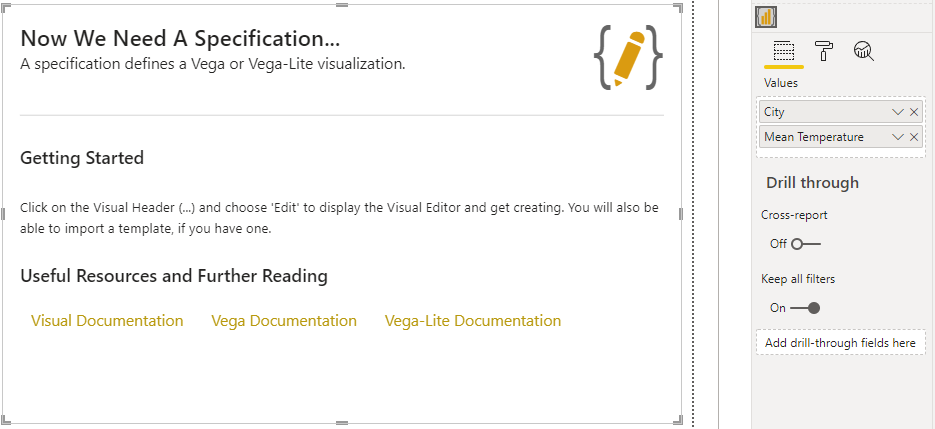
At this point, we need to create a specification, which is required to instruct Vega-Lite (or Vega) how your visualization should be rendered.
Opening the Visual Editor
We can now open the Visual Editor by selecting the visual header (...) and then Edit, e.g.:
This will display the Visual Editor in focus mode, and the Create New Specification dialog will be shown, e.g.:
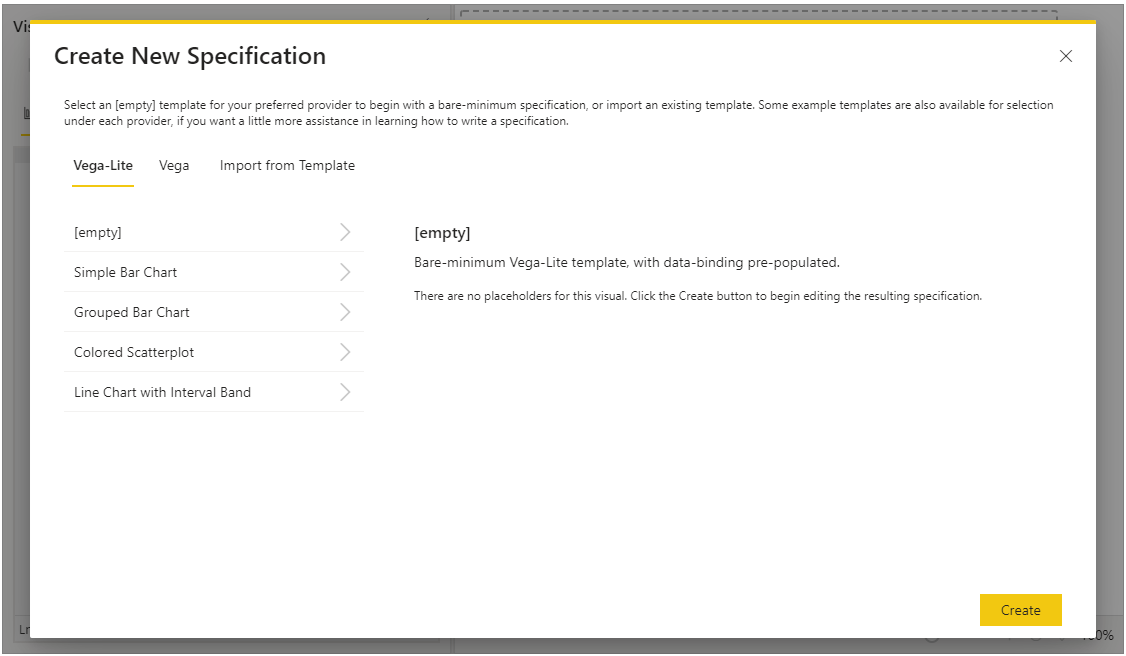
If you accidentally dismiss the dialog, or it doesn't show, you can bring it up by clicking on the New Specification button on the command bar, or using [Ctrl + Alt + N]
Selecting the Template
Using Vega or Vega-Lite requires a specification to be written using JSON. You can either select the [empty] template to begin editing with a bare-minimum specification with the dataset bound to it, or use a predefined template.
Let's choose the Simple Bar Chart template by clicking on it. Note that we now get some additional details about the template, as well as some required placeholders:
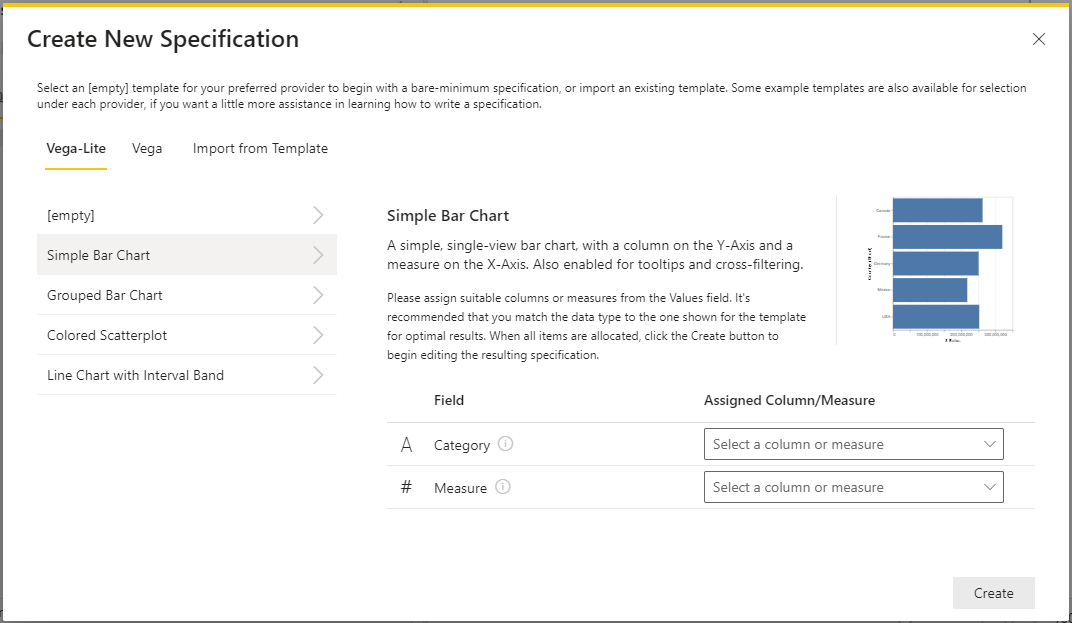
Assigning Placeholders
This template expects two placeholders: one for the the category axis and another for the measure axis. As we've already added our data, we can see these are already available in the dropdown lists, e.g.:

In our case, we'll add City to the Category placeholder.
You can choose either the column or the measure - the recommended data type is shown next to each one so that you can visually confirm the right type of field to bind to the placeholder. Using an different type might work, but be prepared to have to make some changes afterwards if you proceed with this.
Deneb can only see columns or measures added to the Values data role. This is a limitation of visuals in Power BI so that they cannot know more about your data model than they are supposed to. You can add or swap out a column or measure if it's not the one you want and the dropdown list will update accordingly.
Next, we'll click on the Measure placeholder and select the Mean Temperature measure:

Creating the Initial Specification
Now that all placeholders have been filled, the Create button is enabled:
Clicking on this will show the visual specification in the Visual Editor with our assigned placeholders, e.g.:

Reviewing Generated Specification
In our editor's Specification tab, we'll now have the following Vega-Lite JSON specification:
{
"data": { "name": "dataset" },
"layer": [
{
"mark": {
"type": "bar",
"opacity": 0.3,
"tooltip": true
},
"encoding": {
"x": { "field": "Mean Temperature" }
}
},
{
"mark": {
"type": "bar",
"tooltip": true
},
"encoding": {
"x": {
"field": "Mean Temperature__highlight"
},
"opacity": {
"condition": {
"test": {
"field": "__selected__",
"equal": "off"
},
"value": 0
},
"value": 1
}
}
}
],
"encoding": {
"y": {
"field": "City",
"type": "nominal"
},
"x": {
"type": "quantitative",
"axis": { "title": "Mean Temperature" }
}
}
}
This breaks down as follows:
-
There's a
dataobject, which has a mapping of"dataset"(line 2).- This is required for the specification, instructs that our visual's dataset should be used and should be left as-is.
- Refer to the Dataset page for more details on how this works.
-
We have a
layerview, which allows us to superimpose chart elements (lines 3-35). Within this layer, we have:-
One
barmark for each data point (lines 4-13).- The width (
xencoding channel) of this bar is bound to ourMean Temperaturemeasure (line 11). - We're displaying a
tooltipfor this mark (line 8). - This is used to display orginal values in the event of a cross-highlight from another visual (more on this below)
- The width (
-
One
barmark for each data point that is bound to ourMean Temperaturemeasure's cross-highlight values in thexencoding channel (lines 14-34).- The
opacityof our mark (how 'solid' the color appears) is linked to a special field called__selected__, which manages cross-filtering for us (lines 23-32). This is also explained further below, so just bear with us for now.
- The
-
-
The encoding for the visual's top-level (lines 36-45) maps our data as follows:
Cityis mapped to the y-axis and is a nominal/categorical field (lines 37-40).- Our x-axis is a quantitative/linear (lines 41-44).
As noted above, this is a layered view, so that we can try and show you how to make your visual work with Power BI's interactivity features in as simple a way as possible. Vega-Lite also has single, concatenated or faceted views as well, wo it's worth checking those out (with their associated examples) to learn more.
We also have some other stuff going on in the editor's Config tab, thanks to our template...
Reviewing Generated Config
In our editor's Config tab, we'll have the following Vega-Lite JSON configuration. There's a lot going on here, and the intention is to provide you with a more "feature-complete" set of config so that you can see how things can look with a fleshed-out set of properties (and this is based on the powerbi vega theme). You don't need to worry too much about this for the moment.
{
"view": { "stroke": "transparent" },
"font": "Segoe UI",
"arc": {},
"area": {
"line": true,
"opacity": 0.6
},
"bar": {},
"line": {
"strokeWidth": 3,
"strokeCap": "round",
"strokeJoin": "round"
},
"path": {},
"point": { "filled": true, "size": 75 },
"rect": {},
"shape": {},
"symbol": {
"strokeWidth": 1.5,
"size": 50
},
"text": {
"font": "Segoe UI",
"fontSize": 12,
"fill": "#605E5C"
},
"axis": {
"ticks": false,
"grid": false,
"domain": false,
"labelColor": "#605E5C",
"labelFontSize": 12,
"titleFont": "wf_standard-font, helvetica, arial, sans-serif",
"titleColor": "#252423",
"titleFontSize": 16,
"titleFontWeight": "normal"
},
"axisQuantitative": {
"tickCount": 3,
"grid": true,
"gridColor": "#C8C6C4",
"gridDash": [1, 5],
"labelFlush": false
},
"axisX": { "labelPadding": 5 },
"axisY": { "labelPadding": 10 },
"header": {
"titleFont": "wf_standard-font, helvetica, arial, sans-serif",
"titleFontSize": 16,
"titleColor": "#252423",
"labelFont": "Segoe UI",
"labelFontSize": 13.333333333333332,
"labelColor": "#605E5C"
},
"legend": {
"titleFont": "Segoe UI",
"titleFontWeight": "bold",
"titleColor": "#605E5C",
"labelFont": "Segoe UI",
"labelFontSize": 13.333333333333332,
"labelColor": "#605E5C",
"symbolType": "circle",
"symbolSize": 75
}
}
Config is a nice feature of the Vega languages that provides us with the ability to style and set out the cosmetic elements of our visual design away from the main "logic" (which we have in the Specification tab). One thing that's handy for Power BI - due to the ability to dynamically size visuals - is automatic sizing for simpler (single or layered) views - and this is automatically applied for you without needing to specify it.
You can include your config in the specification's JSON at the top-level if you like, but the intention here is to separate the cosmetic aspects of the visual away from its logical ones, so we have a separate tab in the editor for this for those who wish to adopt this approach.
You can extend the config significantly to customize many parts of your visual, so it's worth diving into the documentation for this when you're ready.
The configuration applied above is significantly more than our simple chart needs, but we've prepared this so that the template visuals look "at home" in Power BI, and to give you a jumping-off point for your own ideas. You are free to remove or customize this as much as you like to achieve the visual design you are looking for.
Tooltips
Our template enables tooltips by default, so we can hover over a data point in our visual and this will display a default tooltip, e.g.:
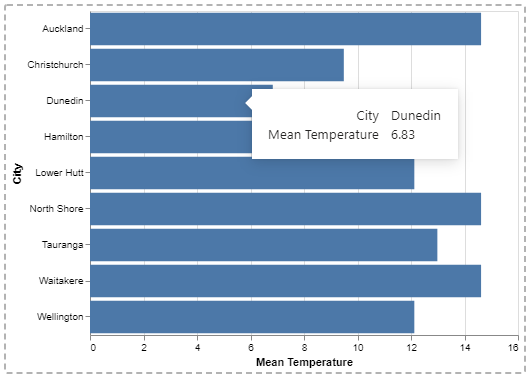
If we were to set up a tooltip page that included one of the columns from our visual, then, the visual can resolve this, providing that you specify to use a report page tooltip instead of a default one, e.g.:
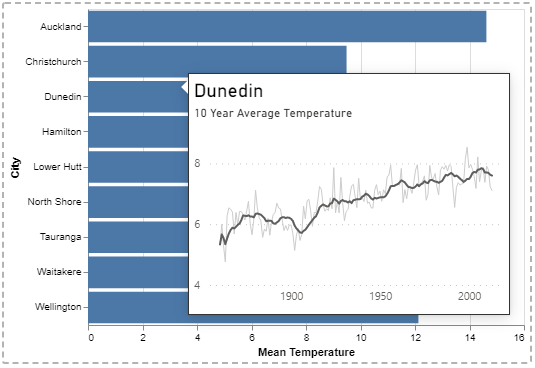
Note that report page tooltips will only work if your data point hasn't been transformed or mutated from the row context passed-into your visual's dataset. In the cases where data points cannot be reconciled back to the data model, the visual will display a default tooltip instead. Please refer to the Interactivity Features or Tooltips pages for further details.
Cross-Highlighting
Creators often have their visuals enabled for cross-highlighting, which means that if another visual is clicked, then other visuals will adjust their display to show the highlighted values in context with their original ones.
-
In our visual, we show the original values with our first mark.
Cross-Highlighting: first (less opaque) mark{
"mark": {
"type": "bar",
"opacity": 0.3,
"tooltip": true
},
"encoding": {
"x": { "field": "Mean Temperature" }
}
}This is 30% opaque and is displayed underneath the second mark...
-
...and the second mark is used to show the cross-highlight values.
Cross-Highlighting: second (solid) mark{
"mark": {
"type": "bar",
"tooltip": true
},
"encoding": {
"x": {
"field": "Mean Temperature__highlight"
},
...
}
}If there is no cross-highlight applied, the data point values are the same as the original, and this obscures the mark behind it. This encoding uses the same measure, but with a
__highlightsuffix, which Deneb uses to supply the value we need to show this. The rest of theencodingsection has been omitted as it's used for the next section.
It normally might be a bit much for a simple walkthrough, but it's likely that you're heare because you want to build your own visual that looks and feels at home in Power BI. Cross-highlighting is a part of this journey, so we want to give you a simple way in to this. You can read in more detail in the Interactivity Features or Cross-Highlighting pages for further details.
Cross-Filtering
Many Power BI visuals allow you to cross-filter others by clicking (or Ctrl-clicking data points). We can also do this with Deneb, but there are elements of user experience that we need to consider: most Power BI visuals will dim or fade the un-selected data points so that our users understand what is happening between our visual and others.
This is normally opt-in, but our template already has a simple version of this set-up already. The relevant section of our specification is on lines 25 through 35:
{
"mark": { ... },
"encoding": {
...
"opacity": {
"condition": {
"test": {
"field": "__selected__",
"equal": "off"
},
"value": 0
},
"value": 1
}
}
}
Deneb uses a special field called __selected__ to track the status of each row of our dataset. We can use this in our encoding, along with a test to set the opacity value of our mark to 0 (or hidden) if it is not one of those that we've clicked (or Ctrl-clicked) on, e.g.:

Note that much like report page tooltips, Cross-Filtering will only work well if your data point hasn't been transformed or mutated from the row context passed-into your visual's dataset. In the cases where data points cannot be reconciled back to the data model, this may not work as intended. You also need to manage the visual effects of your selected and un-selected marks. Please refer to the Interactivity Features or Cross-Filtering (Selection) pages for further details.
Adding Further Config
The config that's present in the loaded template should already make the chart look quite at home in our report, but we'll make some small changes to the bar mark we're using. Update the bar property (on line 13) as follows:
"bar": {
"color": "#605E5C",
"cornerRadiusTopRight": 10,
"cornerRadiusBottomRight": 10
},
We can apply our changes by clicking the Apply command, or pressing [ Ctrl + Enter ]:
Note that the Auto-Apply command can be used to ensure changes are applied as you type rather than manually, although this isn't recommended for complex specifications or ones that use a large number of data points.
Once we've applied the changes, our visual updates as follows:
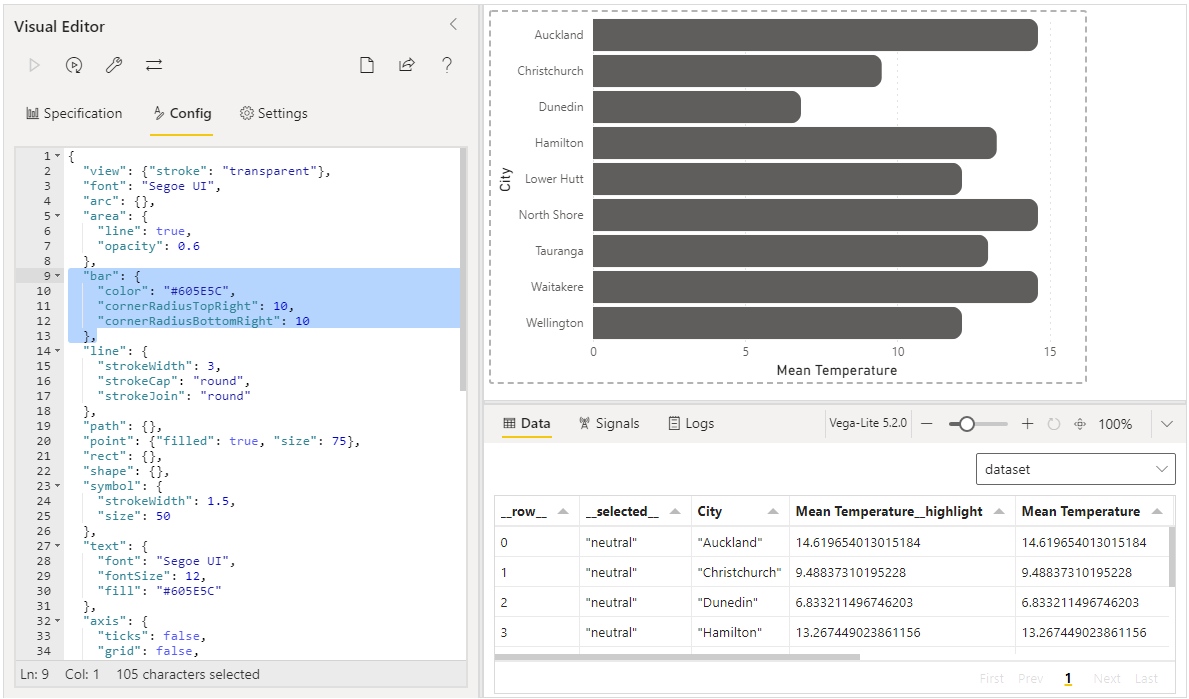
Viewing the Finished Product
When you're finished, click on Back to report to bring you back out of focus mode and to the report canvas. Our visual will now be 'regular sized', thanks to the autosize configuration we applied earlier on:

Where Next?
We've used one of the inbuilt templates to produce a simple example, and add some integration features in the form of tooltips, and customized its appearance using config. A simple visual like this is just the tip of the iceberg and the way ahead is quite broad and expansive.
The purpose of this site is to provide detail on how to make the visual work for you within Power BI, rather than repeating the wealth of great documentation that's already out there. To learn more about some of the additional things the visual can offer (or understand some of its limitations) then please continue to read on or use the menu to explore further.
If you're hungry for more examples or further inspiration, then a good place to start is Vega-Lite's own gallery, or even Vega's gallery.